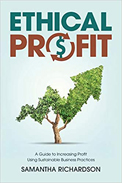
 |
Ethical Profit: A Guide to Increase Profit Using Sustainable Practices
by Samantha Richardson
Writing Pixels Publishing
Speaking directly to a generation of inhabitants hellbent on throwing away the planet, Richardson is adamant that businesses can achieve profits and maintain an environmentally conscious mindset. However, what separates Richardson’s work from other guides on optimal environmental practices is her ability to highlight the indirect costs that arise from being solely profit-oriented. In a nutshell, the work juxtaposes the hidden fees of capitalism with the transparency of sustainability to highlight the advantages both to the individual business as well as the planet that can be reaped with a nurturing mindset toward nature’s resources.
As it stands, compliance is a prevalent dilemma amongst many anti-environmental companies. Despite churning out dollars at an exponential rate, most of these businesses will have to face a reckoning for their role in devastating communities and ecosystems through pollution and toxic substances. Notably, Richardson does not attempt to preach, but rather, she provides context from the historical lens of how the Industrial Revolution and the advent of coal and oil became the catalyst for the profit-engineered climate crisis of the modern world.
Interestingly, there are countless myths concerning becoming environmentally conscious. From products not being up to par to the idea of green living simply being a marketing ploy that’s in fashion, one myth after another is systematically deconstructed and debunked by Richardson. Moreover, the author incorporates a series of case studies that, beyond a shadow of a doubt, demonstrate the impact of hidden costs versus perceived profits. In one, she references Puma’s 2010 finances and 202 million pound profit. Nevertheless, once the carbon footprint was considered, much of the profit evaporated. On a holistic level, businesses focusing on sustainability initiatives like compostable waste will begin to recognize its cyclical pattern and how sustainability will lead the way for rapid consumption.
Among the many perceptions of sustainability, the conundrum of organic food being more expensive is arguably at the top of the list. While organic and sustainable products are undoubtedly pricier than regular ones, the trickle-down effect on overall health and the resulting savings are largely overlooked. Perhaps the best example here, the author suggests, is the hybrid car versus the regular car. The overall benefit of the hybrid car on gas mileage and the environment over the long haul is unimaginable. From digital thermostats and LED lights to water conservation and reusable utensils, Richardson runs the gamut of sustainability, closely examining all aspects of one’s day-to-day life that could thrive with environmentally conscious practices.
Effectively catering to all learning styles, Richardson’s work includes useful tables and diagrams to support the prose and illuminate the simple concept that measuring one’s carbon footprint and environmental impact is not the same as doing something about it. To clearly show how to reduce one’s impact, Richardson helpfully provides an entire section dedicated to ethical investments—a portion of her work that is committed to using the dollar toward sustainable activism. As an epitome of Richardson’s thoroughness, audiences will not only become privy to the more traditional sustainability practices but also the toxicity of the digital world, specifically pointing out pornography and violent video games as culprits to corrupt the mind and inhibit sustainable growth. Overall, Richardson’s work is deeply inquisitive. It is a thought-provoking venture certain to capture the attention of all businesses, compelling them to think deeper about their overall environmental impact.
The 2022 Eric Hoffer Book Award Busines Category Winner and da Vincy Eye Finalist
RECOMMENDED by the US Review